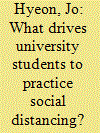|
|
|
Sort Order |
|
|
|
Items / Page
|
|
|
|
|
|
|
| Srl | Item |
| 1 |
ID:
156655


|
|
|
|
|
| Summary/Abstract |
The relationship between gender and political aggression is hotly debated and the empirical evidence is often mixed. While many surveys find a gender gap, with women less supportive of politically motivated aggression and violence than men, numerous case studies point to women’s active involvement in political violence and refute the association of women with peacefulness. This article argues that the gender–aggression relation depends upon (1) the type of political aggression under study (i.e. direct vs. indirect political aggression), and (2) contextual factors, notably the salience of a protracted conflict. Using original datasets representing Israeli Jews (N = 3,126) we found that in the context of protracted conflict, gender has a unique effect on support for indirect forms of political aggression, over and above other central predictors of political aggression (i.e. political orientation and threat perceptions), such that women are actually more supportive of politically motivated social distancing and exclusion of out-groups in conflict as compared to men. Women and men, however, do not differ in their support for direct, politically motivated, violent acts against government officials. Results also shed light on potential mechanisms underlying these differences (and lack thereof), in the context of protracted conflict. The findings cast further doubt on the stereotype of ‘peaceful women’ and point to the need for policymakers concerned with conflict resolution to address context-related factors when considering the gender-based differences in political aggression.
|
|
|
|
|
|
|
|
|
|
|
|
|
|
|
|
| 2 |
ID:
171692


|
|
|
|
|
| Summary/Abstract |
Following the 2013–2014 protests against then Ukrainian president Viktor Yanukovych, Russia’s annexation of Crimea and the armed conflict in Donbas, one of the major challenges for Ukrainian society has been the displacement of over two million of its inhabitants. In 2015, at the peak of the displacement, Ukraine found itself among the five countries in the world, after Yemen, Syria, Iraq and Nigeria, with the highest number of internally displaced persons (IDPs) associated with conflict and violence, and it continues to rank highest in Europe. Very little research has been done to provide a detailed analysis of how internally displaced persons living in Ukraine and outside the country claim and negotiate their belonging in the aftermath of the Revolution of Dignity and the ensuing war. Feeling of belonging is constructed through a relational process of self- and external categorisation and depends on acknowledgement by other members of the chosen group, therefore this essay also examines the strength and regional specificity of the social distancing towards different groups of Ukrainian IDPs.
|
|
|
|
|
|
|
|
|
|
|
|
|
|
|
|
| 3 |
ID:
191109


|
|
|
|
|
| Summary/Abstract |
As COVID-19 has caused unprecedented social change, governments are implementing several social measures to control transmission. Among them, social distancing is being enforced in almost all countries and is effective in preventing infection. Based on the importance of social distancing, this study identifies factors influencing the intention towards social distancing. The research model was developed by introducing risk perception in the theory of planned behaviour. To examine the proposed model, a survey was conducted with 339 university students from two countries, South Korea and Vietnam. The data were analysed using the partial least squares method. The results show that social distancing attitude and perceived behavioural control significantly influence social distancing intention. The findings indicate that both affective risk perception and cognitive risk perception serve as imperative factors in the formation of social distancing attitudes, subjective norms and perceived behavioural control. However, subjective norms and nationality do not affect social distancing intention. Based on the results, suggestions are made for policymakers to establish effective social measures.
|
|
|
|
|
|
|
|
|
|
|
|
|
|
|
|
|
|
|
|
|